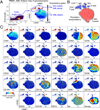Methods for discovery and characterization of cell subsets in high dimensional mass cytometry data
- PMID: 25979346
- PMCID: PMC4468028
- DOI: 10.1016/j.ymeth.2015.05.008
Methods for discovery and characterization of cell subsets in high dimensional mass cytometry data
Abstract
The flood of high-dimensional data resulting from mass cytometry experiments that measure more than 40 features of individual cells has stimulated creation of new single cell computational biology tools. These tools draw on advances in the field of machine learning to capture multi-parametric relationships and reveal cells that are easily overlooked in traditional analysis. Here, we introduce a workflow for high dimensional mass cytometry data that emphasizes unsupervised approaches and visualizes data in both single cell and population level views. This workflow includes three central components that are common across mass cytometry analysis approaches: (1) distinguishing initial populations, (2) revealing cell subsets, and (3) characterizing subset features. In the implementation described here, viSNE, SPADE, and heatmaps were used sequentially to comprehensively characterize and compare healthy and malignant human tissue samples. The use of multiple methods helps provide a comprehensive view of results, and the largely unsupervised workflow facilitates automation and helps researchers avoid missing cell populations with unusual or unexpected phenotypes. Together, these methods develop a framework for future machine learning of cell identity.
Keywords: Flow cytometry; Machine learning; Mass cytometry; Single cell biology; Unsupervised analysis.
Copyright © 2015 Elsevier Inc. All rights reserved.
Conflict of interest statement
Figures



References
-
- Bandura DR, Baranov VI, Ornatsky OI, Antonov A, Kinach R, Lou X, Pavlov S, Vorobiev S, Dick JE, Tanner SD. Analytical chemistry. 2009;81:6813–6822. - PubMed
-
- Ornatsky O, Bandura D, Baranov V, Nitz M, Winnik MA, Tanner S. Journal of immunological methods. 2010;361:1–20. - PubMed
-
- Aghaeepour N, Finak G, Flow CAPC, Consortium D, Hoos H, Mosmann TR, Brinkman R, Gottardo R, Scheuermann RH. Nature methods. 2013;10:228–238.
Publication types
MeSH terms
Grants and funding
LinkOut - more resources
Full Text Sources
Other Literature Sources

